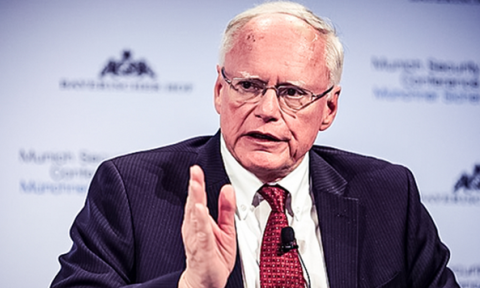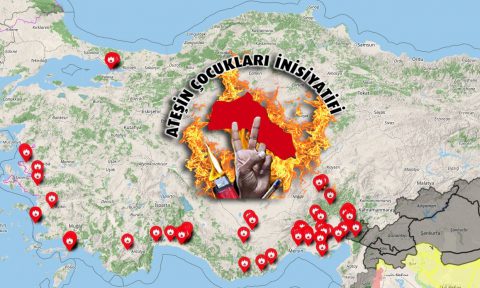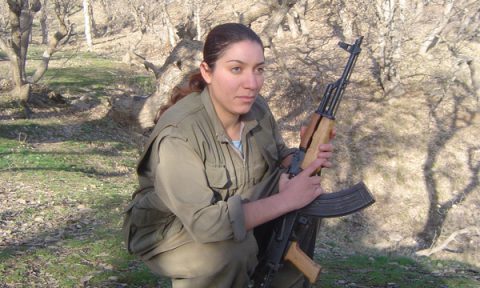Iran as a Mountain Bulwark
To properly understand Iran’s position in the Middle East, one must not only look at its religion, internal affairs or its complex foreign politics, but simply its topography and history. One look at the map shows you several important facts about the country. Iran is a vast country, it measures 1,684,000 square kilometers, and is thus larger than the whole of Western Europe combined. It is also very mountainous, with mountain ranges and the ocean as its frontiers. The Zagros mountains run 900 kilometers long from the North-Western border adjoining Turkey and Armenia to the South-East towards the Strait of Hormuz and its largest harbours of Bandar Abbas. In the North, the Alborz mountains stretch from its border with Azerbaijan, along the Caspian sea to the Afghan border in the East, forming a buffer to Turkmenistan’s Karakum desert. Mountains of lesser elevations then swing down along the Afghan and Pakistani borders, almost to the Arabian Sea. The Iranians themselves are mountain people. The majority of its 70 million population lives in the mountains, with even its capital Tehran situated in the hills at the foot of the Alborz.
The Iranian heartland is hardly inhabitated. It consists of two desert plateaus, the Dasht-e Kavir and the Dasht-e Lut, consisting of salt-mud flats that one easily breaks through, and are virtually impassible and uninhabitable. But on the western side, right between the Zagros mountains and the two plateau, the landscape forms a natural bridge between the Persian gulf in the south and the Caspian sea in the north. Iran also forms a bridge between the Indian subcontinent and the Mediterranean Sea. It’s a defensive bulwark, its mountains and wasteland make it nearly impossible to conquer it by land, with nothing but ocean in the south.

Demography and Ethnic Dissent
Iran with its highly strategic position, connecting North to South and West to East, and its large oil reserves, it has always been an attractive location for foreign occupiers. While its landscape makes it militarily impossible to conquer, its highly diverse demography makes its easy to manipulate. A thing we see often in mountainous regions, the Iranian ethnic and national groups have been able to retain their own culture and characteristics. It is also religiously divided between the vastly dominant Shia and the minority Sunnis, who are clustered in three areas of the country — the northeast, the northwest and the southeast. Any foreign power interested in Iran will try to manipulate these ethno-religious groups to undermine the power of the central government. Thus, impenetrable but vulnerable to manipulation as it is, any Iranian government has maintaining the internal integrity of the country against separatist groups as its primary strategic interest.
Contemporary powers trying to control or overthrow Iran, have tried so through sowing ethnic or religious dissent among the diverse groups inside the country. This can be witnessed by studying its history.

Saddam Hussain was quick to discover that a direct assault through the Zagros mountains, Iran’s frontier, was not quite feasable in 1980. But the British colonialists, interested in Iran as a bridge to India previously based in Iraq, were able to manipulate internal political divisions in Iran, as did the Soviets, and by doing so, Iran virtually lost its national sovereignty during World War II. The view of the contemporary Iranian government toward the United States is not only that of ideological animosity, but that it assumed Britain’s former imperialist role of using its current position in Iraq to manipulate Iranian politics in an attempt to overthrow it by sowing internal discord.
Historically, Iranians also have been concerned about Russian manipulation and manipulation by the British and Russians through Afghanistan. Iranians are thus in their right to assume that the lasting American occupation of Afghanistan is not at all related to ‘freedom and democracy’ or ‘saving the Afghan people from the radical Taliban’, but in fact a strategy to hold foot the surroundings of Iran, something it was unsuccesful to do in the neighbouring Pakistan. In the southeast, in Iran’s Balochistan, both the Americans and Arab regimes have supported several separatist movements, exploiting the ethnic and religious diversity of its local population. They have also done this among the Arabs of Khuzestan, at the northern end of the Persian Gulf. Most succesful have Iran’s enemies been in manipulating the Kurds in northwestern Iran by providing support to a palette of seperatist organizations and fueling the dream of an independent Kurdistan. Other evidence suggests that the Americans and Saudi’s have tried to use Azerbaijan as a launchpad to sow dissent among the Iranian Azeris in the northwestern part of the country in the past, and something pan-Turkists have tried more recently.
As has been proven in Iran’s long history, the country’s weak spot lies here.
The ‘Axis of Resistance’ as a Counter-Strategy
To counter these manipulations attempts by its enemies, Iran has not only formed a complex intelligence apparatus on Iranian soil, it has also sought to form its own alliances in its vast surroundings and diminish its enemies’ influence in the region. It has tried to establish a Shiite crescent in the notionally crescent-shaped region of the Middle East where the majority population is Shia or where there is a strong Shia minority present. The most famous alliance in this crescent is often dubbed ‘the Axis of Resistance’. Over the last decade this term has come to identify areas under Iranian influence. Areas included in the Shia Crescent are Lebanon, Syria, Bahrain, Iraq, Iran, Azerbaijan, Yemen, and western Afghanistan.
By developing this anti-colonialist influence strategy, Iran is in fact winning the war for the Middle East. Though unable to openly militarily confrontate its enemies, it has tipped the balance in the region to its advantage by developing a sovereign capability to conduct warfare through third parties. It does so by contesting its enemies through assymetrical warfare through non-state partners, instead of resolving to simply bombing its enemies or conducting traditional state-against-state battles. Atrocities committed by occupiers in the region have only fueled Tehran’s sovereign capability. Aligned by a common enemy, Iran has become the main player in a network that represents a mosaic of local and regional factions. And in fact, this capability has become of higher strategic value to Iran than missiles, its own armed forces, or even the development of nuclear weapons.
Iran has formed its identity in the region by defending its allies to the end, holding fast to its partnerships, and repeat the narrative of resistance. It has been succesful in doing so by its differences in strategy to foreign occupiers. Iran has never attempted to occupy or harm the sovereignity of another country. Instead, it has pursued non-state partnerships with ‘the weak and the oppressed’. By doing so, it has not only sought to aid groups sharing its religion or anti-imperialist ideology, it has literally formed a cocoon of protection surrounding itself in a region under continuous foreign attack.

It is obvious that Iran has been succesful at this strategy, as its enemies only dare to attack its assets or allies (f.e. the killing of general Qassem Soleimani and the assassination of the Iranian scientist Fakhrizade), instead of attacking Iran on Iranian soil itself.
Iran, Sanctions, and Strategic Economic Partnerships
It has been almost three years since President Trump reneged on the 2015 nuclear deal that rolled back Iran’s nuclear activities and placed them under the most rigorous international inspection regime ever implemented anywhere. Yet, his ‘Maximum pressure’ campaign will not make Iran yield. There is little doubt that the administration’s “maximum pressure” policy is inflicting considerable economic harm on Iran. The Iranian currency has lost two-thirds of its value, as oil exports have dropped by more than half and will likely fall further still. Civilians inside the country suffer tremendously because of these sanctions, yet a narrative of ‘survive and resist’ has kept them on their feet.
Iran has learned to be self-sufficient over the past four decades, and though its geographics do not lend for major industrial expansion, it has a continuously sought to seek new opportunities and alternative partnerships in the region. Burdened by sanctions, and a terrible coronavirus outbreak, Iran has turned East, to China, for economic and military support. Falling Iranian oil prices have enticed China to look for astute alternatives for cheaper energy resources, in a way to commonly undermine the United States. In fact, the Treasury Department had sanctioned Chinese firms for conducting business with Iran at least twice last year.
In 2020, a leaked document showed that a 25-year strategic partnership would be implemented between the two countries, in which China would invest in Iranian infrastructure, transport and seaports, in exchange, Iran would provide a heavily discounted regular supply of its oil. The year before, Iran had signed onto Xi Jinping’s signature One Belt One Road plan, making Iran a key part in China’s race to the top of the economic world order. Iran and China are currently renovating rails to connect Ürümqi in China’s autonomous Uyghur region to Tehran, as well as connect Kazakhstan, Kyrgyzstan, Uzbekistan and Turkmenistan. This ‘new silk road’ will make transport across Asia more attractive and much faster than shipment.
The governments of Turkey, Iran and Pakistan have also announced to revive a transnational rail service linking Istanbul, Tehran and Islamabad this year. The ITI transnational railroad will enhance connectivity with China’s Belt and Road Initiative by providing a rail connection between China and Turkey. By extending the railroad to Turkey, Iran is positioning itself as a key transportation hub, forming a bridge between West and East, as it was in history. It is also a handy way to avoid sanctions, as the ECO countries on this alternative trade route trade in local currencies and will thus be less affected by US sanctions in dealing with Iran.
By sanctioning Iran heavily, the US has actually done more harm to itself than to Iran, as it has pushed Iran into the arms of US’s rivals China and Russia with no return. Iran exported natural gas to Turkey, Iraq, and Armenia since a long time, yet US sanctions have made Turkey and Armenia look for alternatives for gas supply. But having only lost a battle, together with China and Russia, Iran has defeated the US in the “pipeline wars”. Russia, Iran, and Turkmenistan hold, respectively, the world’s largest, second-largest, and fourth-largest gas reserves and China will be consumer par excellence in this century. Together with the ECO-countries, these partners have revived – and planned to revive many more – pipeline connections through the Caucasus and Central Asia, undermining the US’s regional goals.
Even when it comes to the COVID-19 vaccine, Iran has refused to work with its enemies. Vaccines produced by the US and the United Kingdom will be banned from entering Iran, its supreme leader has said yesterday. “Imports of US and British vaccines into the country are forbidden. They’re completely untrustworthy,” Ayatollah Ali Khamenei said in a live television speech. “It’s not unlikely they would want to contaminate other nations.”

The country has developed its own vaccine, which is currently being tested. State media outlets have also reported that Iran will eventually receive one million vaccine doses from China, and perhaps Russia.
The US’s Future Strategy for Iran
When it comes to the economic chessboard, the United States has suffered great losses to Russia and China during the Trump-administration. Both Russia and China have proved reliable future partners for Iran, that was pushed in their arms as a direct result of US sanctions. Iran’s growing partnerships with China and Russia show that Iran is capable of growing beyond its military partnerships in the Middle East, the Shia crescent, and might even become a major player in the world through the following decades. Fortuned by its natural reserves and geostrategic location, the West cannot ban the rest of the world from trading with Iran forever.
As it is afraid of the ever-growing Iranian influence in the region, the US will not completely back out of the Middle East militarily anytime soon. It cannot eradicate Iranian influence, as every attempt to do so has backlashed horribly. Killing general Qassem Soleimani has only entrenched sentiments for the resistance’s Iranian friends even more. An all-out military confrontation with Iran is too risky for Iran’s enemies, as Iran has made tremendous efforts in the development of long-distance weapons that can cause a lot of damage and loss of life at the home front. Iran is no country that intends to capitulate at the slightest attack and will defend itself.
Yet, Iran’s enemies will focus on its minorities and armed opposition even more in its conquest to harm Iran from within. They will fund, arm and train them even more than before. Anti-Iranian think-tanks and propaganda machines will be fueled increasingly in an attempt to ignite popular uprisings. A pattern we have witnessed in Syria, Libya and several other countries before.
This article is written in cooperation with Iranian Kurdistan Human Rights Watch (IKHRW)










